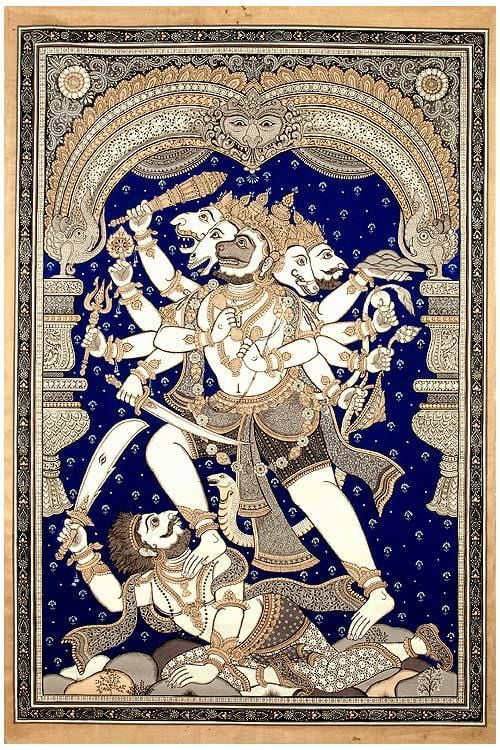In Hindu mythology, Hanuman is revered as an embodiment of devotion, strength, and loyalty. One of the fascinating depictions of Hanuman is Panchamukhi Hanuman, where he is portrayed with five faces, each carrying profound symbolism and spiritual significance. The legend of Panchamukhi Hanuman originates from the Ramayana, specifically during the intense battle between Lord Rama’s army and the demon king Ravana’s forces.
As the conflict escalated, Ravana’s brother Ahiravana, a formidable sorcerer, devised a sinister plan to abduct Lord Rama and Lakshmana. Seeking the help of Mahiravana, another malevolent entity skilled in dark magic, Ahiravana posed a grave threat. Hanuman, ever vigilant in protecting his beloved lord and brother, faced the challenge posed by Mahiravana’s cunning tactics.
Recognizing the need for a unique approach, Hanuman tapped into his divine prowess and manifested as Panchamukhi Hanuman with five distinct faces symbolizing various aspects of divinity. The narrative unfolds with Hanuman’s journey into the netherworld, where Mahiravana had taken refuge. Confronting numerous obstacles, Hanuman’s realization that conventional means were insufficient led to the manifestation of Panchamukhi Hanuman.
The five faces of Panchamukhi Hanuman carry specific representations:
1. Hanuman (Facing East): Symbolizing strength, courage, and unwavering devotion to Lord Rama.
2. Narasimha (Facing South): The lion-headed form representing fearlessness and protection against evil forces.
3. Garuda (Facing West): Depicting the divine eagle, symbolizing speed, agility, and the power to overcome obstacles swiftly.
4. Varaha (Facing North): The boar-headed form signifying resilience and the ability to delve into the depths to recover what is lost.
5. Hayagriva (Facing Upwards): The horse-headed deity representing wisdom, knowledge, and divine grace.
Panchamukhi Hanuman’s unique form enabled him to thwart Mahiravana’s plans, rescue Lord Rama and Lakshmana, and emerge victorious in the battle against darkness.
The story of Panchamukhi Hanuman holds profound symbolic significance, providing insights into various aspects of spiritual practice and personal growth:
- Devotion and Surrender: Hanuman’s unwavering devotion to Lord Rama exemplifies bhakti (devotion). Panchamukhi Hanuman’s deep dive into his being reflects the surrender required in the path of devotion.
- Conquest of Evil: The battle against Mahiravana symbolizes the eternal struggle between good and evil. Panchamukhi Hanuman’s triumph emphasizes righteousness prevailing over malevolence.
- Multi-dimensional Nature of Divinity: Each face of Panchamukhi Hanuman represents a different aspect of divinity, showcasing the multi-dimensional nature of the divine. Spiritual growth involves integrating various qualities such as strength, wisdom, courage, and protection.
- Overcoming Obstacles: Panchamukhi Hanuman’s different faces signify diverse approaches to overcoming obstacles. Just as Hanuman adapts various forms to navigate challenges, individuals are encouraged to use different strategies in their journey towards self-realization.
- Inner Transformation: Hanuman’s transformation into Panchamukhi Hanuman symbolizes inner transformation and self-realization. It underscores tapping into one’s latent potential and transcending limitations to realize one’s true nature.
- Universal Harmony: The amalgamation of different divine forms in Panchamukhi Hanuman signifies underlying unity and harmony within the universe. It reinforces the idea that, despite apparent differences, all aspects of creation are interconnected and emanate from the same divine source.
In conclusion, the mythological narrative of Panchamukhi Hanuman serves as a profound allegory rich with spiritual and philosophical insights. Through Hanuman’s exploits and his manifestation as Panchamukhi Hanuman, the tale elucidates timeless truths about devotion, courage, and the triumph of good over evil. The symbolism inherent in Panchamukhi Hanuman underscores the holistic nature of spiritual growth and the interconnectedness of all aspects of existence. This legend continues to inspire millions, offering guidance and solace on the path of righteousness and self-discovery.







